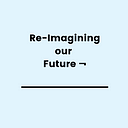Re-Imagining Touch
Whether or not we agree with the evidence and logic used to introduce lockdowns and regulations to curb social interaction, the pandemic has unnaturally disrupted and interrupted the way we normally interact as human beings: primarily through distancing and barriers (masks, elbow-to-elbow greetings…)
Could it be that corporations who place more value on cost-savings than the well-being of their employees will seek to permanently entrench the work-from-home paradigm and social distancing, supported by an unchecked Fourth Industrial Revolution — to such an extent (and without proper research) that it harms employees in the longer run? Increases their sense of separation, isolation, uncertainty, absence of warmth, anxiety and loneliness? And harms family and social relationships?
A 1976 movie told of a boy who had no immunity against disease and lived inside a plastic bubble.
Totally isolated. Quarantined. Alone.
Everything that he consumed or read or played with were given to him through a specially sealed opening, by people who wore gloves and had first sanitized what they passed to him.
Otherwise he would be contaminated and die instantly.
As he deteriorated and it became clear that he was dying, he asked if he could reach for and touch his father outside of the plastic bubble. He knew that this would mean instant death.
But he reached outside of his bubble and touched his father’s hand ….
Around the World, the story that is being told, received and believed is that it is right to be threatened by and fearful of others who may infect and harm us. “Stranger-anxiety” has entered the lexicon of therapists.
Here’s the thing:
“The sense of touch is the first bodily sense developed in an embryo. And our skin becomes the biggest sensory organ. It covers the whole surface of our body. Our skin is made up of millions of highly sensitive sensors that immediately tell us when something is happening to our skin. Think of what a little breeze feels like, a drop of sweat running down your forehead, an ant crawling over your toes. Psychologists tell us that no mammal can explore and develop properly without contact. Physiotherapists notice how negative feelings can be released through a massage. A gentle touch on our shoulder, our back, or our stomach can generate feelings of wellbeing. But it can also release tears, when one realizes for how long one has not been touched”. — Robert Steiner
Holding hands and singing, hugging, an encouraging back pat, a consoling touch, wiping away another’s tears. There is healing power in touch. Touch settles and calms, reassures, conveys care, facilitates relationship building and psychological safety, allows us to naturally build immunity.
Can you imagine a World without touch?
Do we need a balanced approach, one that combines high-tech with high touch, and one that appreciates the value of touch, proximity, inclusivity and belonging, security and freedom of choice? How key are these basic human needs in providing a safe environment for better community and workplace performance?
How do we make sure that we don’t lose touch?
Yesterday, while watching a recording of a conversation between Alanis Morrisette and Dan Siegel, from the Embodiment Conference, Alanis mentioned that we, as a society, are not ‘touched’ enough. The pandemic has exacerbated this, but even before the pandemic, this was the case. Just gently touch your face, run your hands down your neck, chest, belly, inner thighs, back to your face, gently caressing and feeling the beauty of touch. Is there a sensation? What does that sensation feel like? How often do you feel that sensation?
Physiologically, humans are vulnerable. Our ribs protect our heart. But, our guts (one of our three brains) are exposed. There is a big difference between good touch and bad touch. Good touch requires deep trust and respect, and is vital to our well-being. How can we build that trust, to include more touch. Would this mean, we would hug more people, more often, with increased warmth, and care? Could this be that we would take part in community events, where touch is emphasised (i.e. massage, acro-yoga, interplay etc.)? Could you imagine a casual conversation in a cafe, where you exchanged back scratches with the person you were talking with (I would love this!)? What ways could you imagine where good touch would become more common in your life? In a social-distanced COVID world, how can we compensate?
Lead Author: Graham Williams (first 5 paragraphs)
Graham is the author of the book The Halo and the Noose, the Power of Storytelling and Story Listening in Business Life. Graham offers a series of workshops ranging from applying Da Vinci for personal growth to exploring African Stories. You can reach out to Graham through his website and/or via e-mail, centserv@iafrica.com.
This is the second post that Graham has contributed to the series. If you haven’t yet, check out his first post, Re-Imagining Compassion.
Anchor Author: Daniel Rudolph
Daniel Rudolph is interested in exploring alternative, experiential learning opportunities for people of all ages. He is passionate about forming community, and building public spaces for meaningful, transformational gathering. Currently he is spending a lot of his time learning juggling and facilitating gatherings. He also enjoys writing and sharing poetry. Daniel is a very curious and playful person and is always open for creative collaborations.
